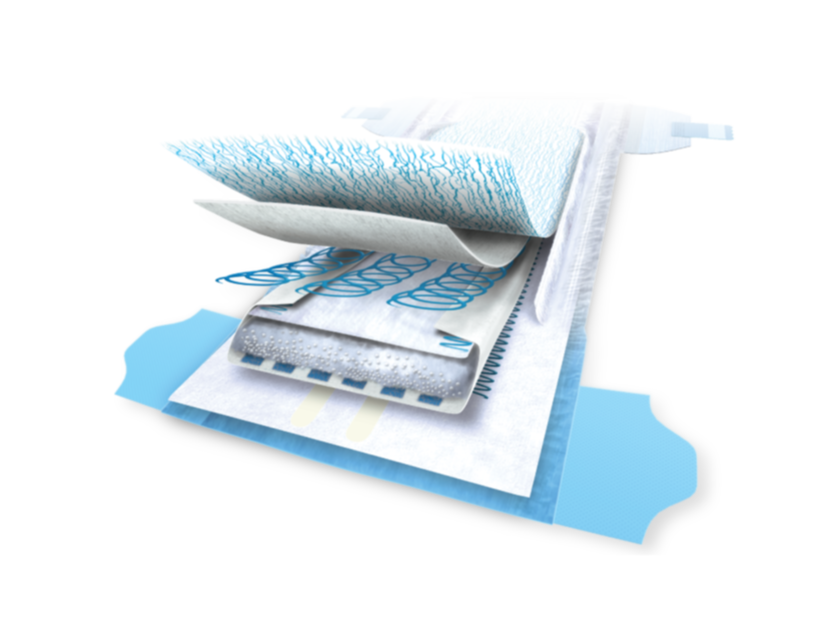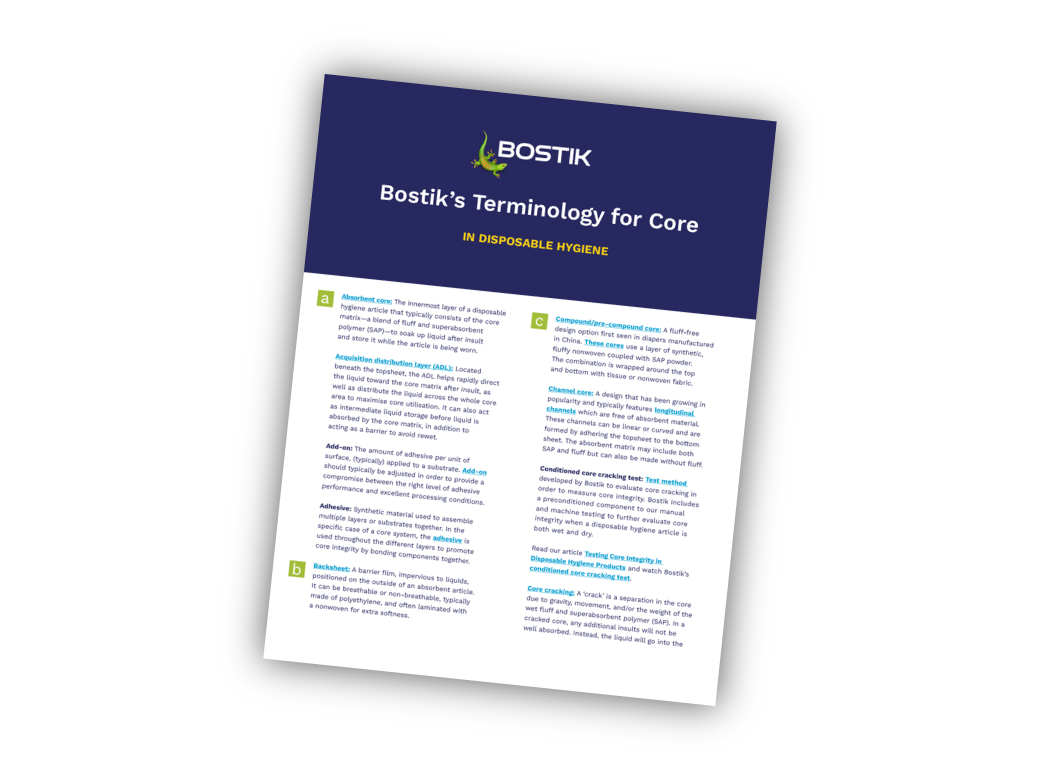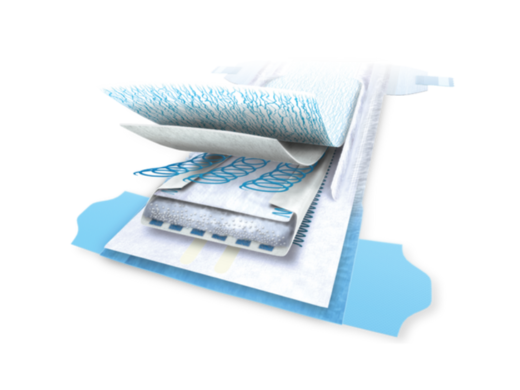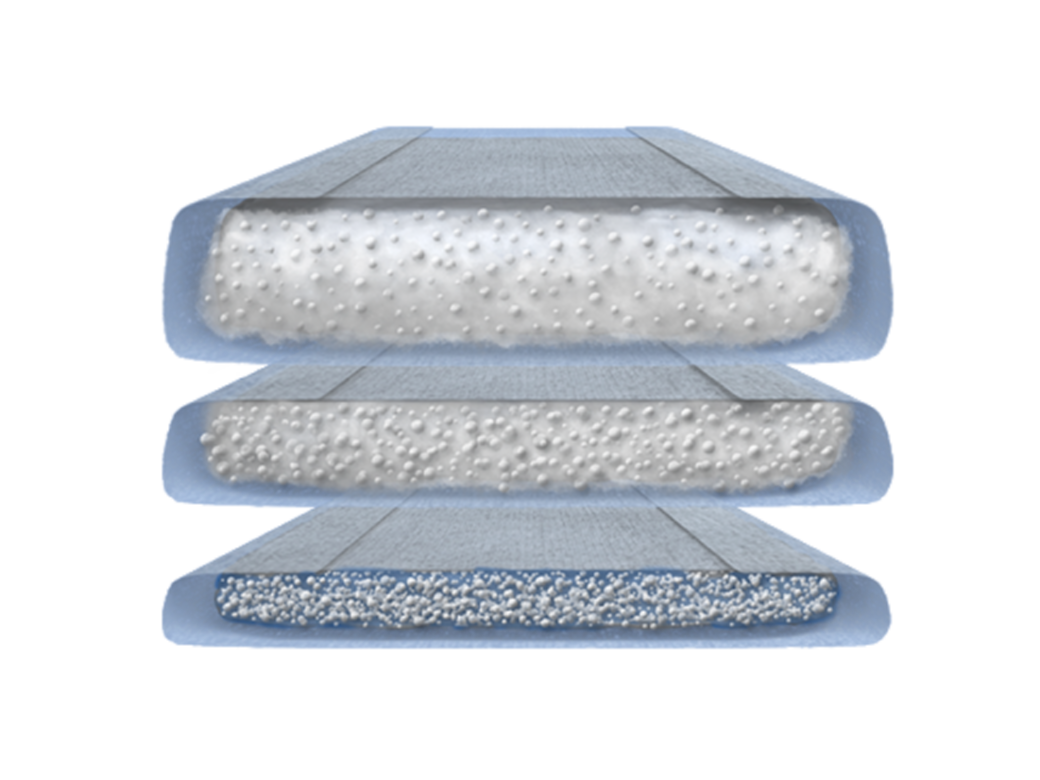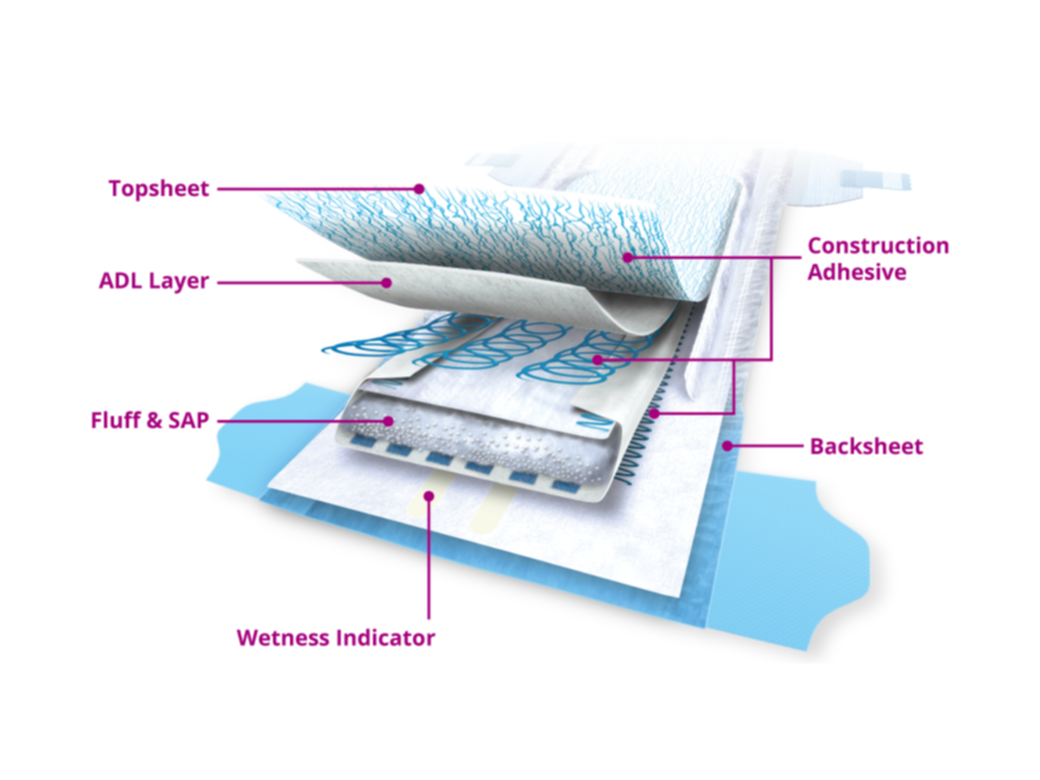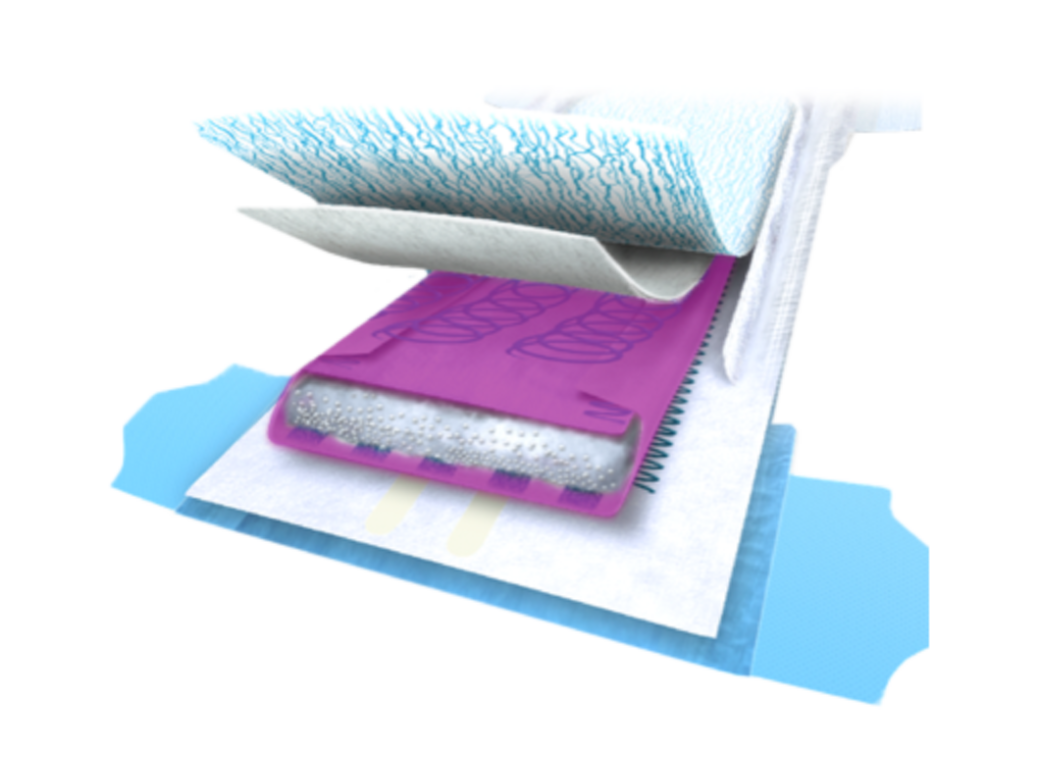Terminology for Absorbent Core in Disposable Hygiene
Access a printer-friendly PDF version here.
Absorbent core: The innermost layer of a disposable hygiene article that typically consists of the core matrix, a blend of fluff and superabsorbent polymer (SAP) to soak up liquid after insult and store it while the article is being worn.
Acquisition distribution layer (ADL): Located beneath the topsheet, the ADL helps rapidly direct the liquid toward the core matrix after insult, as well as distribute the liquid across the whole core area to maximize core utilization. It can also act as intermediate liquid storage before liquid is absorbed by the core matrix, in addition to acting as a barrier to avoid rewet.
Add-on: The amount of adhesive per unit of surface (typically) applied to a substrate. Add-on should typically be adjusted in order to provide a compromise between the right level of adhesive performance and excellent processing conditions.
Adhesive: Synthetic material used to assemble multiple layers or substrates together. In the specific case of a core system, the adhesive is used throughout the different layers to promote core integrity by bonding components together.
Backsheet: A barrier film, impervious to liquids, positioned on the outside of an absorbent article. It can be breathable or non-breathable, typically made of polyethylene, often laminated with a nonwoven for extra softness.
Compound/pre-compound core: A fluff-free design option first seen in diapers manufactured in China. These cores use a layer of synthetic, fluffy nonwoven coupled with SAP powder. The combination is wrapped around the top and bottom with tissue or nonwoven fabric.
Channel core: A design that has been growing in popularity and typically features longitudinal channels which are free of absorbent material. These channels can be linear or curved and are formed by adhering the topsheet to the bottom sheet. The absorbent matrix may include both SAP and fluff but can also be made without fluff.
Conditioned core cracking test: Test method developed by Bostik to evaluate core cracking in order to measure core integrity. Bostik includes a preconditioned component to our manual and machine testing to further evaluate core integrity when a disposable hygiene article is both wet and dry.
Read our article Testing Core Integrity in Disposable Hygiene Products and watch Bostik’s conditioned core cracking test.
Core cracking: A “crack” is a separation in the core due to gravity, movement, and/or the weight of the wet fluff and superabsorbent polymer (SAP). In a cracked core, any additional insults will not be well absorbed. Instead, the liquid will go into the crack and likely leak out of the disposable hygiene article. Testing of articles before and after insult can indicate if cracking is occurring. This would indicate a need to optimise the design to ensure the consumer does not experience core cracking during use.
Core integrity: The ability of the core matrix to stay in one piece, thus avoiding core cracking that creates leakage. Testing can be used to verify a core’s integrity. Request a copy of our whitepaper on Core Integrity.
Core matrix: This is the three-dimensional (3D) network of fibres that composes the fibrous, continuous core layer. Fibres can be cellulose fluff or synthetic nonwoven fibres. Superabsorbent polymer (SAP) particles are added to the matrix for better fluid absorption and storage. The matrix ensures good fluid management and core integrity, as well as good dispersion and fixation of the SAP particles. The matrix also provides a compressible cushion so product wearers do not feel the SAP powder when pressure is applied to the core.
Core ratio: Typically the percentage of fluff versus superabsorbent polymer (SAP) in a core matrix. As trends in thinner cores emerge and spread across the global market, changes in the fluff to SAP ratio has been moving towards higher SAP contents, and alternative core designs have become more common. In the traditional core, this shift creates challenges for production and performance, and the role of the adhesive increases.
Core system: A variety of intricate disposable hygiene article components that work together to prevent leakage and help keep the wearer’s skin dry. It includes the absorbent core, the topsheet and the acquisition distribution layer. A top-performing core must also be supported by a well-matched system of stretch and elastic adhesives to maintain its shape, even when wet.
Core wrap: A layer that provides containment for the fluff and superabsorbent polymer (SAP) in order to facilitate the manufacturing process (and avoid fibre or powder contamination) and/or to improve performance and stabilize the core matrix. Either tissue or nonwoven wraps are typically used.
Fluff: Cellulose fibres used as the core matrix. It is often blended with superabsorbent polymer (SAP). Fluff ensures rapid liquid absorption and wicking of liquid through capillary forces. It assists with core integrity by preventing core cracking and slumping.
Fluff-free core: Absorbent core designs where fluff fibres have been completely omitted. Fluff-free core designs need to find alternative solutions to perform the function of fluff, i.e., to absorb liquid instantly, to ensure wicking, and to create a core matrix.
Insult: The discharge of bodily fluid(s) such as urine or blood.
Leakage: The result of bodily fluid (or runny faeces) escaping the absorbent article, typically at the legs or at the back, depending on gravity and which is closest to the insult point.
Leg cuffs: Elasticised hydrophobic layers that supplement the leg elastics to conform around the legs of the wearer and avoid leakage. While not typically considered part of the core system, leg cuffs act as a barrier to allow the core matrix time for absorption.
Odour control: The action of mitigating, eliminating and/or masking the odour generated by bodily fluids either shortly after insult or after some time. Some manufacturers are exploring options such as using activated carbon and natural elements to control product odour during use, sometimes even before use. Materials used in the core matrix also play a vital role in improving odour control after insult. Chemically modified fluff and superabsorbent polymer (SAP) may help lower pH levels and neutralize ammonia generated after urine makes contact with skin bacteria.
Rewet: Usually measured in grams, this is the amount of liquid that, under pressure, comes back from the absorbent core through the acquisition distribution layer and the topsheet to wet the skin.
Superabsorbent polymer (SAP): A generally synthetic polymer, mostly in powder form, that has the remarkable ability to retain large volumes of fluid relative to weight, even under pressure. SAP alone absorbs liquid relatively slowly and has very poor wicking properties.
Topsheet: This layer of the core system makes direct contact with the wearer’s skin and directs the liquid rapidly toward the absorbent core. Additives that promote skin health, such as lotion or aloe, are sometimes included on the topsheet. The topsheet also plays a role in preventing liquid from coming back up to wet the skin, hence reducing risk of rewet.
Wetness indicator: A functional adhesive and a common feature in many disposable diapers. When the wetness indicator makes contact with liquid after insult, it visually indicates that the diaper pad is wet and the product needs changing.
